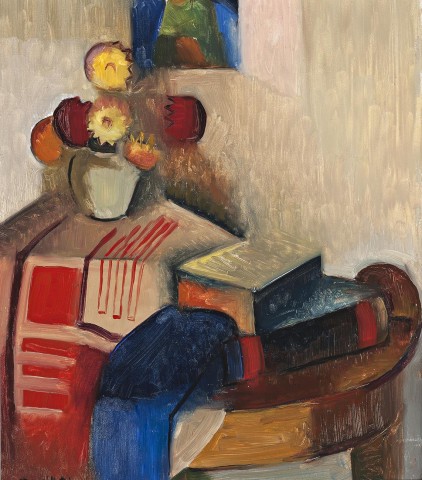STILL LIFE (DAHLIAS), c.1929 – 30
DORRIT BLACK
oil on wood panel
39.0 x 33.0 cm
signed lower left: Dorrit Black
Private collection
Christie's, Melbourne, 11 July 1977, lot 54A
Mrs Louis M. Robson, Adelaide
Important Women Artists Gallery, Melbourne
Private collection, Melbourne, acquired from the above in 1978
Dorrit Black, Macquarie Galleries, Sydney, 10 – 20 September 1930, cat. 18 (label attached verso)
Dorrit Black, Royal South Australian Society of Arts Gallery, Adelaide, 7 – 23 July 1938, cat. 15(b)
North, I., The Art of Dorrit Black, Macmillan and the Art Gallery of South Australia, Adelaide, 1979, O.34, p. 122
In late 1929, after two years of study and travel in England and Europe, Dorrit Black returned to Adelaide armed with firsthand knowledge and experience of international developments in modern art. Through the subsequent exhibition of her paintings and prints, her teaching, and energetic proselytising, Black joined the ranks of a small group of female artists, including Grace Crowley, Anne Dangar, and earlier, Margaret Preston, among others, who contributed to the introduction and spread of progressive artistic approaches in Australia.
Following studies at the South Australian School of Art in Adelaide and later with Julian Ashton in Sydney, Black sailed for England in 1927, attending classes with Claude Flight at the Grosvenor School of Modern Art. Flight revolutionised printmaking in the 1920s and 30s through his passionate advocacy of the colour linocut – regarding it as the modern medium for the modern age – and Black (followed by other Australians, Ethel Spowers and Eveline Syme), absorbed his example of the use of bold colour, the reduction of subject matter to simplified shapes, and patterns based on a dynamic system of opposing rhythmic lines and forms. Moving to Paris in December, Black studied with André Lhote, one of the early exponents of Cubism, whose teaching was, in her words, ‘from the standpoint of design, which is the basis of all modern work … He judges the work from standards of rhythm, balance, proportion and line, and applies these standards to its three properties – form, tone and colour’.1 The final element of Black’s education came from Albert Gleizes, whose example incorporated rhythmic movement into radically stylised compositions, offering ‘a bridge from cubism to pure abstraction: from the static to the dynamic’.2
Still Life (Dahlias), c.1929 – 30 features a familiar table-top arrangement of elements – books, a tablecloth (itself bearing a strikingly modern geometric design), and a vase of flowers – and the lower half of a framed picture is visible hanging on the wall behind. But while the subject is traditional, its treatment is far from it, as Black compresses pictorial space and merges some forms with others (the uppermost book and wall for example), introducing multiple fragmented viewpoints into the image. Visible brushstrokes lend the work a painterly energy and the bold colours of Black’s palette – from the royal blue of the draped cloth to the burgundy and yellow of the dahlias – draw the eye around the picture, highlighting the geometry that underpins its composition. This work was exhibited in 1930 alongside one of Black’s best known paintings, The Bridge, 1930 (Art Gallery of South Australia, Adelaide), in her first solo presentation at Macquarie Galleries, Sydney. Confounding one critic with its display of ‘ultra-modern methods’3, the exhibition bewildered another with its interpretation of subject matter ‘in geometrical terms’ and radical ‘adventures in forms’.4
A label on the back of the small wood panel suggests that Still Life (Dahlias) was included in one of the New English Art Club’s annual exhibitions, however her diary, which records extended travels in Europe, the United Kingdom, the United States and Canada in 1934 – 35, notes on 6 November 1934 that, ‘Today I have been to the New English Art Club, which repeatedly does not include either of my pictures’.5 It was at this time that Black did however receive significant recognition for her work when the Victoria and Albert Museum purchased an impression of the linocut, The Pot Plant, 1933, for its permanent collection.6
1. Dorrit Black quoted in Lock-Weir, T., Dorrit Black: Unseen Forces, exhibition catalogue, Art Gallery of South Australia, Adelaide, 2014, p. 36
2. ibid., p. 56. See Harding, L., ‘L’Esprit Nouveau 1913-1929’ in Harding, L. and Cramer, S., Cubism and Australian Art, exhibition catalogue, The Miegunyah Press & Heide Museum of Modern Art, Carlton, 2009, pp. 36 – 47
3. Simpson, C., ‘Geometry and Queer Colour’, Daily Guardian, 14 September 1930 quoted in North, I., The Art of Dorrit Black, Macmillan, Melbourne, 1979, p. 53
4. ‘Art Exhibition – Miss Dorrit Black’s Pictures’, Sydney Morning Herald, 11 September 1930 quoted in ibid.
5. Black, D., Travel Diaries, 1934-35, ‘England, Scotland, North America 6 October 1934 - 4 October 1935’, p. 25, Art Gallery of South Australia Research Library, Dorrit Black papers. It is possible that the label was issued by the New English Art Club to identify works submitted for consideration. I am grateful to Tracey Lock-Weir, Curator of Australian Art, Art Gallery of South Australia, for her assistance confirming this point.
6. Lock-Weir, op. cit., pp. 78 – 79
KIRSTY GRANT
